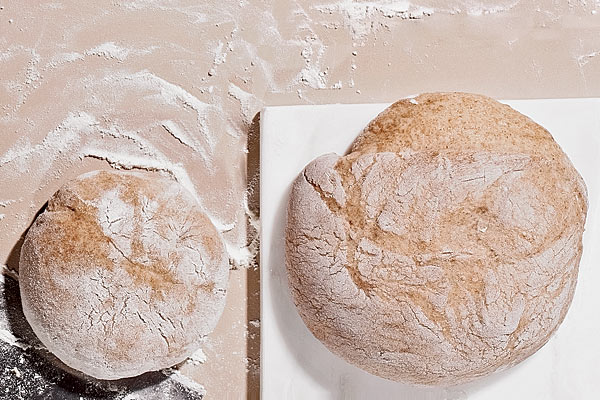
Not long ago, discerning bread lovers had only a handful of options around Chicago. Places like D’Amato’s, Bennison’s, and Red Hen Bread reigned supreme, and competition was scarce. But lately, bread shopping has become a bit more complicated. A number of new bakers—and even grocery stores—have jumped in, and along with them comes the term “artisanal bread,” a popular but misleading catchall, like “gourmet coffee.”
For the uninitiated, true artisanal bread is made as it was centuries ago: A long-fermented dough of flour, water, salt, and yeast is shaped by hand and baked in a hearth oven. When done right, artisanal bread is delicious, but the process is brutal, time-consuming, and expensive, and just because a baker advertises artisanal bread doesn’t mean it’s worth the money. So we asked Bennison’s Jory Downer, a grand prize winner in the Coupe du Monde de la Boulangerie—the Olympics of artisanal baking—to break down the best gauge of a baker’s talents: the baguette.
Thin crust. It should be like an eggshell, a sign that the baguette was baked at the proper temperature and steamed at precisely the right time. A baguette crust should break but never bend: When you bite or tear it, the crust should put up a brief fight, then surrender and break into particles. Also, listen to your bread: “You should hear it when you give it a good squeeze,” says Downer. Bad bread doesn’t make a sound.
Amber-toned crust. An amber color means, among other things, that the starch in the dough has turned into a simple sugar and caramelized. A pale crust is a hint the dough has been underbaked or overfermented; a dark crust means the transformed sugars have been overbaked and have become bitter.
A smooth bottom. Next time you’re in Subway, pick up the bread and look at the bottom. See all those tiny dimples? A telltale sign the bread has been mass-produced on screens or in machines rather than in a hearth oven.
That beer smell. Before you take a bite, break into the baguette and inhale. “The aroma can tell you more than anything,” Downer says. “Because it tells you if it’s been properly fermented.” The bread should have a nutty, slightly tangy, mildly sour scent. It shouldn’t smell musty or overwhelmingly sour, but it should have a distinct aroma. If it doesn’t—think white bread at Jewel—you can be sure it was fermented with additives.
Off-white crumb. If the crumb is too white, the baker probably used bleached flour—cardinal sin number one—or the dough was overmixed.
Open structure. Look for different-size bubbles and pores in the bread, which make it more palatable and easier to digest. A subpar bread will contain tiny bubbles, perhaps because the baker didn’t use enough water or chose the wrong flour.
Mouthfeel. The bread should be extremely soft and ball up a bit when you chew it. If a baker used a flour with too much protein (a rookie mistake), the bread will be chewy or gummy. Baguettes should not remind you of bagels.
TRUE BREAD
Six places to find artisanal baguettes
Bennison’s Bakery 1000 Davis St., Evanston; 847-328-9434
Floriole Cafe & Bakery 1220 W. Webster Ave.; 773-883-1313
Fox & Obel 401 E. Illinois St.; 312-410-7301
La Boulangerie 2569 N. Milwaukee Ave.; 773-358-2569
La Farine Bakery 1461 W. Chicago Ave.; 312-850-4019
Red Hen Bread 1623 N. Milwaukee Ave., 773-342-6823; 500 W. Diversey Pkwy., 773-248-6025; 736 Lake St., Oak Park, 708-383-7360


